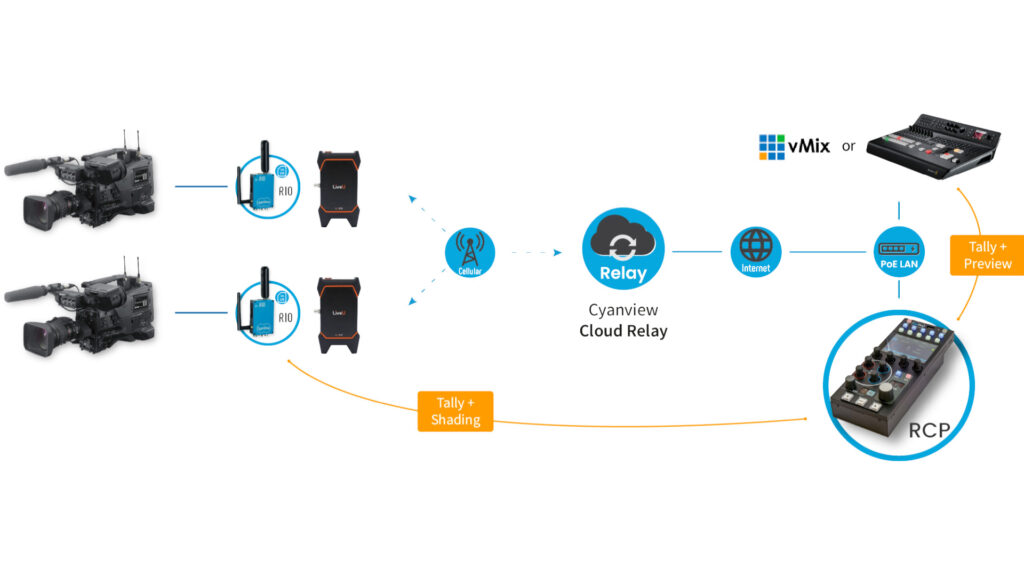TPC (Technology and Production Center) has been gradually expanding their use of Cyanview products since their first exploratory use of the equipment in 2019. We met TPC at the NAB show in Las Vegas where we demonstrated an early version of RIO, our system for camera control over the internet and over the cellular network. TPC is using Cyanview for most of its specialty camera needs; wireless camcorders, mini-cams, PTZ cameras and for colour correction.
The Tour de Suisse deployment will see a fleet of CyanView RIOs used in conjunction with Sony cameras mounted on the pace motorbikes, a Cineflex camera in overhead helicopter, and two Sony shoulder cams positioned at the start and finish lines. The RIO allows for IP-based camera control and signal tally (either external or sent directly to the camera) of serial, USB or WIFI cameras and a range of associated lenses, and in the case of the Tour de Suisse implementation will route control data via 4G cellular network. It will use external antennas instead of the slightly more typical USB dongle mounts, thus increasing reliability without the complexity of additional RF setup. Due to the low packet demands associated with camera control, real-time control with next to no latency is entirely achievable.
In the very few cases where cellular signal may not be available (such as high up in the Swiss mountains), the addition of two VP4 units will allow for an additional eight channels of video processing to shade the cameras in post instead of directly on the head. Shading on the VP4 also facilitates colour correction and synchronisation in situations where video is sent over cellular and latency issues on the path might lead to camera shading difficulties. When combined with a dual LiveU cellular video/Vislink RF data transmission, this will provide the production team with maximum flexibility – allowing the production team to switch setups as necessary, on-the-fly, thus ensuring integrity and reliability of broadcast through built-in redundancy.
The central advantage of CyanView control systems – which includes not just the RIO units but also central RCP control units installed in the OB vans – is their ability to work with and harmonise a wide range of mainstream and speciality cameras, significantly simplifying workflows in broadcasts which use multi-cam setups with different colour properties. The RIO units are built with robust aluminium casing to allow deployment in high energy, high impact environments, whilst the CyanView RCP unit allows for multi-cam control in a simplified, intuitive manner – using VSM preview to automatically switch camera on the RCP itself, rather than requiring manual selection. All of these features – combined with the inherent benefits of IP – make CyanView products ideal for remote and live production.
Speaking of TPC’s use of CyanView cameras in the Tour de Suisse, Mirco Stalder, Specialist Video Engineer on the production, said: “We use a range of cameras in our productions because of the versatility this gives us in creating immersive and engaging coverage. But it also presents complexities in coordination, synchronisation and colour matching – a factor which is vital in terms of the quality of the output. CyanView products virtually eliminate these complexities, unifying complex setups and allowing them to be controlled quickly, easily and reliably from a single source”.
On the 2020 edition of the Tour de Suisse, eight Cyanview RCP’s were used for wireless camcorder control and also to provide tally data to the camera operators. The same equipment is now being used on lower budget, REMI (remote integration model) productions, which are now in ever growing demand.
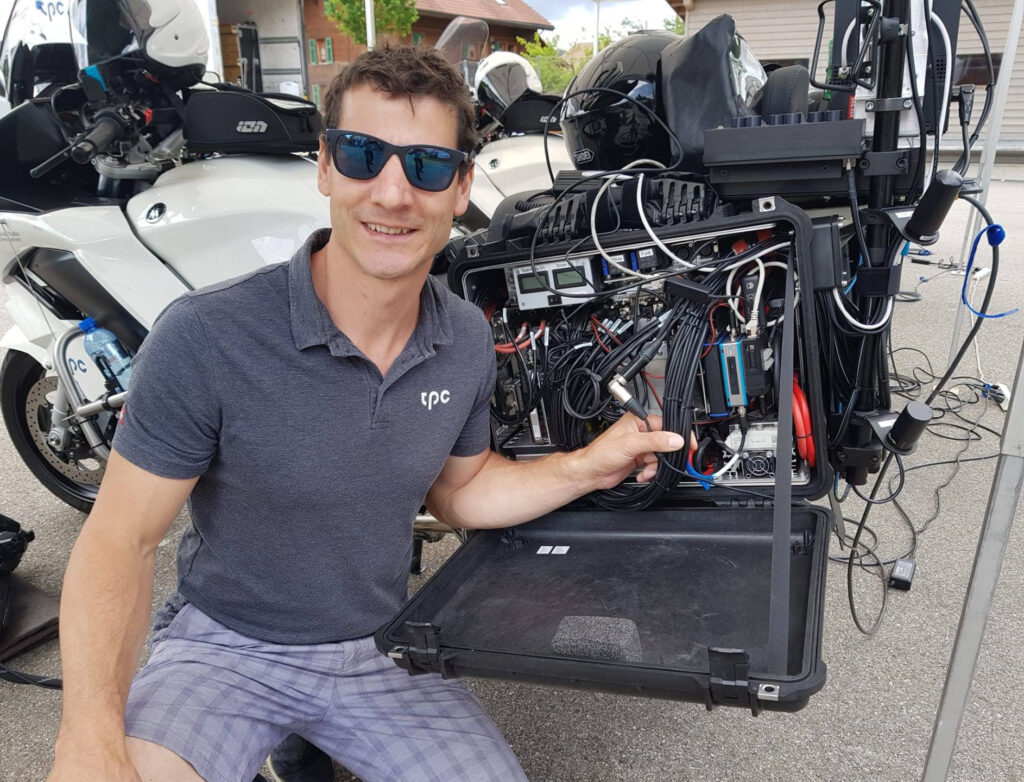
Case Study : Three workflows utilised by TPC
This article illustrates three typical workflows utilised by TPC: Tour de Suisse with wireless cameras, mini-cameras used on various sports productions and finally remote production. You can use the table of contents to jump directly to the different sections.
1. Tour de Suisse Cycle Race with wireless cameras
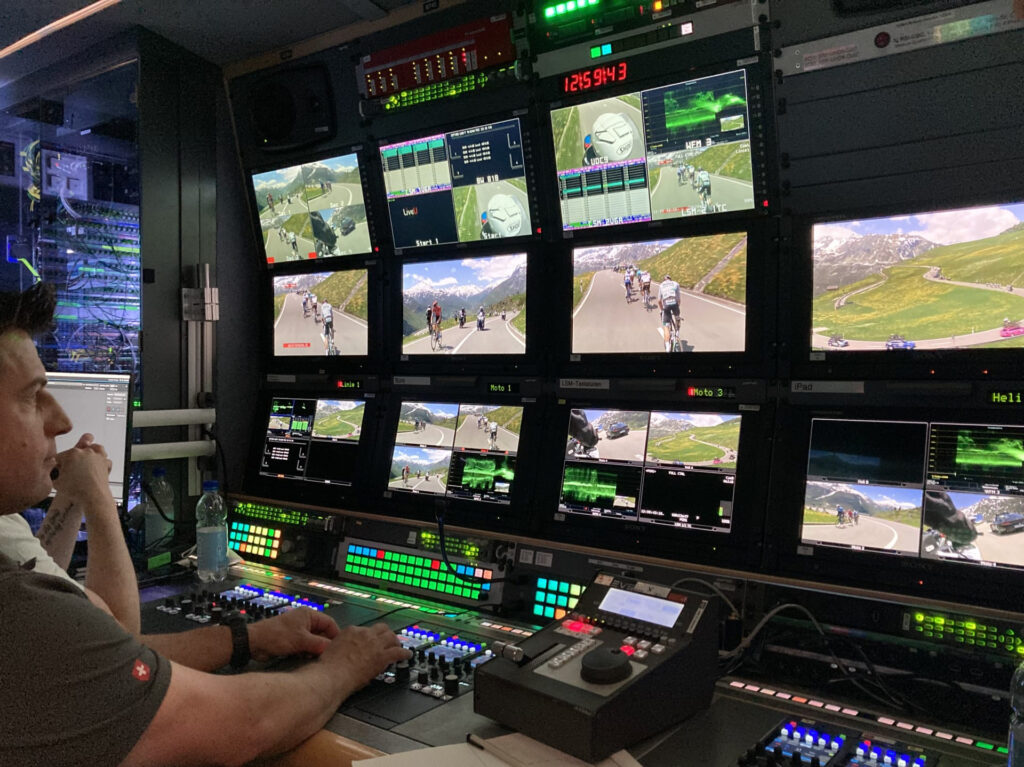
The setup we provided for this multi-stage cycle race included the following solutions:
– Eight Cyanview RCP’s were installed in the main OB truck.
– The motorbikes were equipped with Sony P1’s or P50’s, with the control data being routed via a RIO over the cellular network. The camera tally was driven directly as an integral part of the control data stream whilst an additional external tally signal was provided by the same RIO for the motorbike rider. In order to obtain the best possible reception, SRF used a cellular modem equipped with external antennas instead of the more usual USB dongles that plug directly into the RIO.
– The helicopter was carrying a CineFlex camera system under the control of a local OCP but otherwise had a similar setup to the bikes with a RIO equipped with an identical cellular modem providing a tally output to the pilot.
– Two Sony PMW 500 shoulder operated camcorders were used with conventional RF links on the start and finish lines. Two RIO’s were again used for camera control and to provide tally data over the cellular network using a standard 4G dongle and a direct connection to the Sony 8-pin remote connector on the camera.
– Two VP4 control units provided an additional eight channels of processing. These provide colour correction as well as synchronisation functionality. The VP4’s were used when remote control wasn’t available in specific geographic areas of the race with limited or no 4G signal. It was also an option when latency issues on the video path made it difficult to achieve positive and accurate shading adjustments. This was typically when LiveU had to be used to relay the camera pictures when the normal Vislink RF paths were not available, and again, the VP4’s provided colour correction under these circumstances.
– Tally ingest was done using the GPIO port on a Cyanview NIO IP box or via the RCP GPIO port.
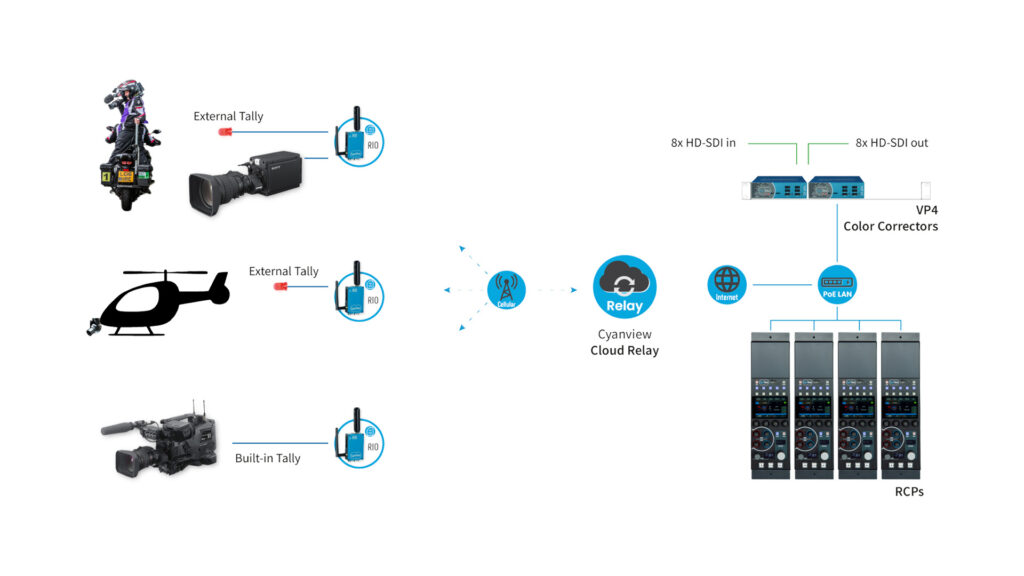
Speaking of TPC’s use of CyanView cameras in the Tour de Suisse, Mirco Stalder, Specialist Video Engineer on the production, said:
“We use a range of cameras in our productions because of the versatility this gives us in creating immersive and engaging coverage. But it also presents complexities in coordination, synchronisation and colour matching – a factor which is vital in terms of the quality of the output. CyanView products virtually eliminate these complexities, unifying complex setups and allowing them to be controlled quickly, easily and reliably from a single source”.
RIO for wireless camera control and tally
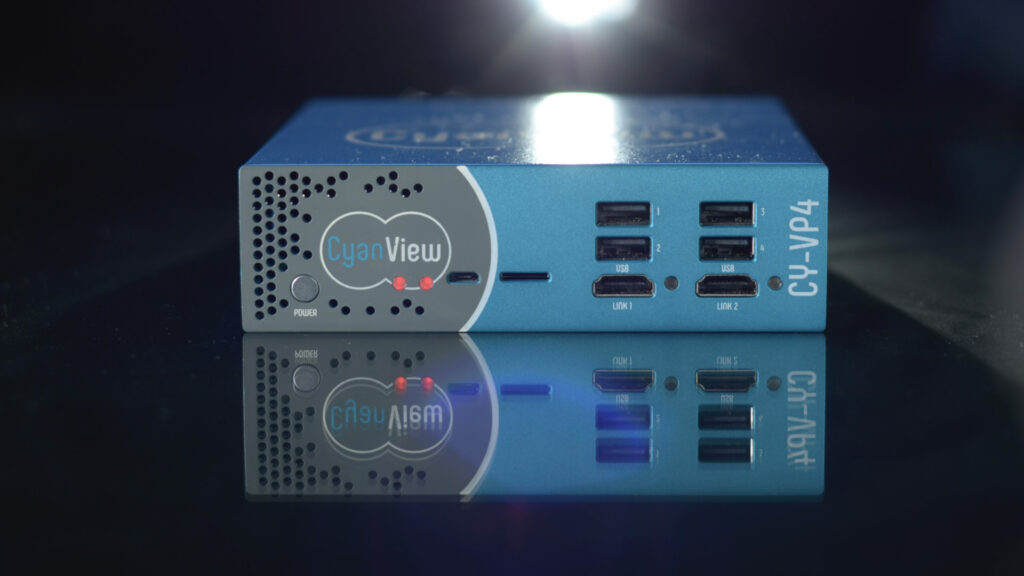
The primary use of the VP4 was to shade and synchronise the helicopter camera signal. Whilst the RIO unit providing the tally signal to the pilot could have been used for camera control as well, on this occasion access to the camera control port on the Cineflex system wasn’t easily achievable.
Cyanview’s VP4 provides the advanced functionality necessary for critical colour matching (RB gain, black balance, saturation, multi-matrix etc.) as well as synchronisation functionality. The VP4 is ideal to shade and match cameras when you have no camera control as it provides similar settings as you would expect to have in a CCU, directly accessible from the same RCP.
VP4’s were also dedicated to the motorbike camera signals. Whilst these cameras have remote control, there were two reasons to have the VP4 available as well:
– To allow the shading of cameras in areas where the 4G signal wasn’t available
– To allow shading with no operational latency issues when the LiveU cellular video transmitters are in use
When the Vislink RF transmitters were used, there was no latency in the video, nor in the control data, and so the VP4 wasn’t necessary for colour correction, only as a synchroniser. When the transmission switched to LiveU cellular video, there was a latency of a few seconds which made it impossible to react quickly enough with the necessary shading adjustments. This is the reason why the motorbike cameras would go through a VP4 channel even if camera control was available. In such situations, it was much more convenient to handle small and quick adjustments on the VP4 rather than on the camera directly. Larger adjustments could still be done on the camera head as and when appropriate.
For the start and finish line cameras, wireless RF video was always available as well as cellular data and for remote control and so the VP4 wasn’t necessary in those circumstances..
Multi-cam RCP
When using specialty cameras, one RCP is typically used to control multiple cameras. The possibility of integration with the VSM preview control system makes it quick and easy to access any camera or video processor channel as you don’t have to select the camera on the RCP itself, it just follows your VSM preview panel selection. In the case of the Tour de Suisse, the decision was taken to use eight RCP’s in order to have a dedicated RCP for each of the key cameras. Additional RCP’s were then used in multi-cam control mode to access the various VP4 processor channels.
The RCP interface recently got a software update which allows the handling of camera head as well as post processing channels as part of a unified system. With this update, it is now possible to choose whether some adjustments should be done in the camera head or in the video processor and which one should have priority when the adjustment is possible in both places.
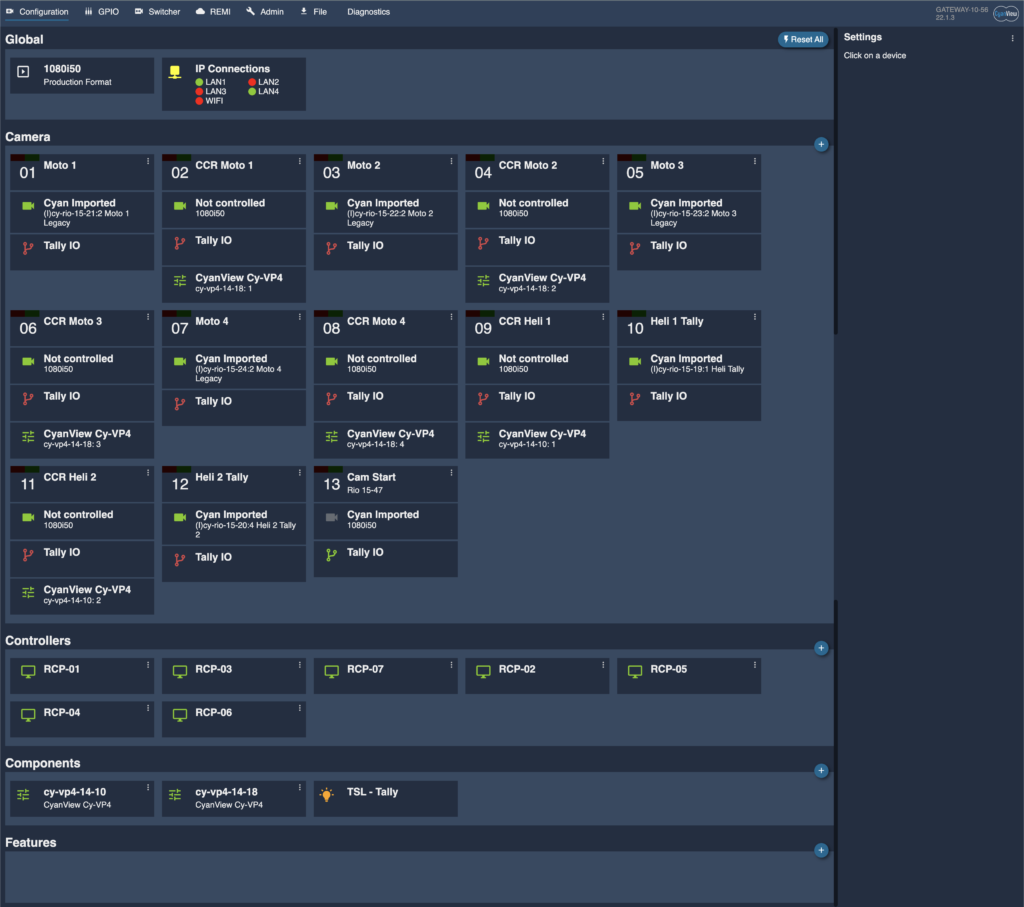
Tally
During the last winter, a similar setup was used on a cross country ski competition. A RIO unit would provide tally data to a helicopter and to a number of snowmobiles, and a VP4 unit was used to match these with the wired system cameras. Several ENG cameras equipped with LiveU transmitters were also controlled using a RIO. TPC chose to use the RCP GPIO port to receive tally data from the main OB truck.
At that ski event, a mini van fitted out with 6 system cameras was also part of the production but located at another remote part of the ski resort. A RIO was incorporated with that setup in order to relay tally information derived from the main OB, over the internet, and to then drive the tally inputs of the 6 CCU’s located therein.
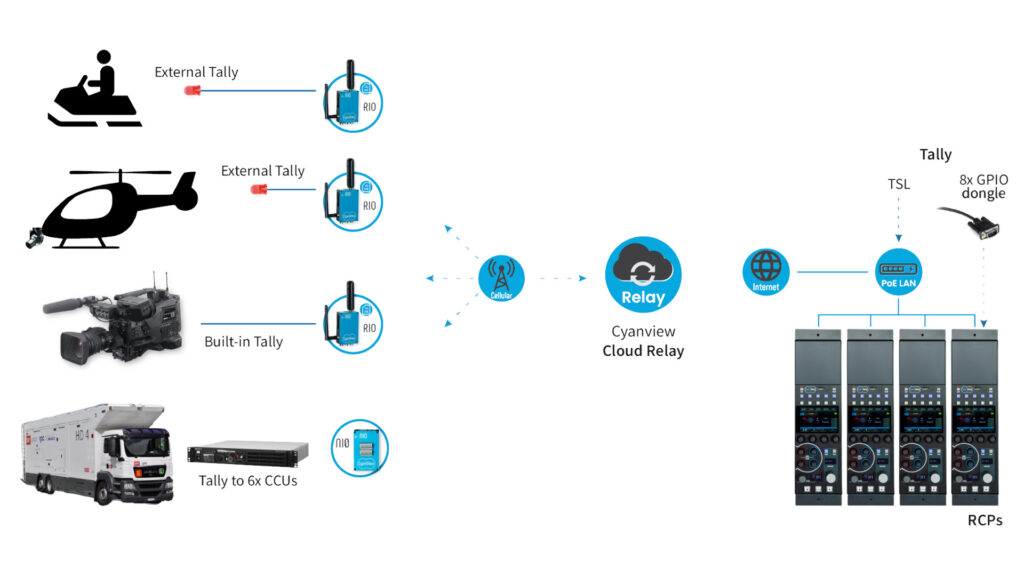
2. PoV Mini-Cams on IP for OB productions
Besides the Tour de Suisse, TPC is now using Cyanview for mini-camera control over IP. They have some AJA Rovocam’s that they use in various hockey stadiums, which are connected to a Cyanview CI0 interface. They also have some Marshall cameras and the Dreamchip Atom One that they use on various sports that are controlled in a similar manner. As they already have one RCP in the OB, adding a mini-cam becomes a plug and play operation as they just have to simply connect the camera and its CI0 interface to a network switch or a media converter. That makes it easy to add cameras for PoV angles such as in goals or along a track, while retaining the camera control necessary for broadcast quality colour matching.
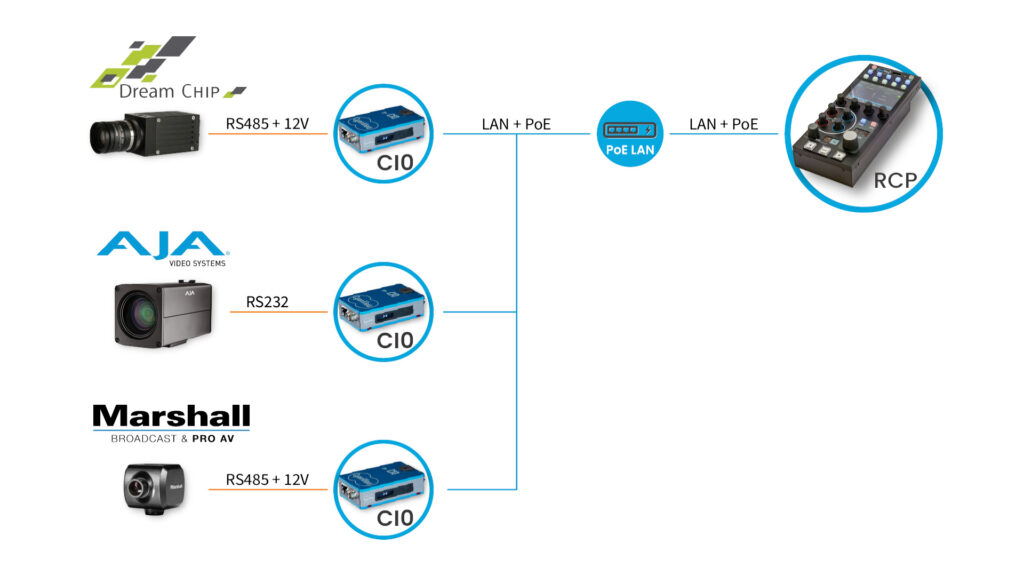
3. Remote Production using cellular
TPC is also involved in the new business model of remote production. More and more small productions are now getting produced with simplified setups on relatively low budgets. Camera matching is still a mark of professional high end productions that they want to hold on to and RIO’s are used to provide remote camera shading and tally data. The Swiss Championship of Gymnastics for example, was captured by 2 ENG camcorders with LiveU systems. The RCP’s were in the studios while the cameras were equipped with a RIO and a 4G dongle. For these kinds of applications, the integration with small switchers is useful in order to provide RCP preview and tally functions. TPC is using Blackmagic Atem and VMix for these smaller productions. Using the IP integration, a tally is directly received by the RCP from the switcher and conveyed to the camera. If one RCP is used, switching the monitoring output of the switcher will also automatically select that camera for control on the RCP. If multiple RCP’s are used, the preview of each RCP will route the corresponding signal to the monitor. Applications range from sports events to Church installations, music concerts and theatre. Although we already have the integration with the Atem switchers, we are now adding the integration with VMix so that TPC can use a single RCP fully integrated with tally and camera switching for the remote production of their church programs.
